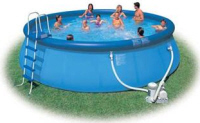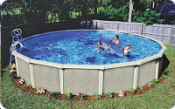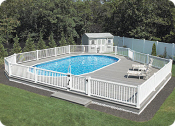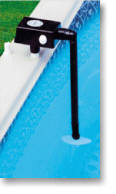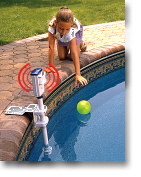Swimming Pool Regulations
Swimming Pool Installation Concerns:
WASHINGTON, D.C. - A new report issued recently by the staff of the U.S. Consumer Product Safety Commission (CPSC) indicates that the average number of drowning deaths involving children younger than 5 in pools and spas has increased from a yearly average of 267 (for 2002-2004) to 283 (for 2003-2005). The average number of emergency room treated pool and spa submersion injuries decreased from an annual average of 2,800
(for 2004-2006) to 2,700 (for 2005-2007). The report also shows that the majority of deaths and injuries occur in residential settings and involve children ages 1-2. Drowning is the leading cause of unintentional death to children ages 1-4.
"The tragedy of hundreds of children dying each year from accidental drowning and four times as many who are near-drowning victims with devastating injuries, is made even more painful by the knowledge that these types of accidents are preventable," said Rep. Debbie Wasserman Schultz. "Parents should know that simple safety measures for their pool or spa could very well prevent their own child from
being lost through such nightmare scenarios as accidental drowning or entrapment."
Drowning occurs more commonly when children get access to the pool during a short lapse in adult supervision. To reduce the risk of drowning, pool owners should adopt several layers of protection, including pool alarms and a physical barriers, such as a fence completely surrounding the pool with self-closing, self-latching gates to prevent unsupervised access by young children. If the house forms a side of the barrier, use alarms on doors leading to the pool area and/or a power safety cover over the pool.
In addition, parents should use these tips to help prevent drowning deaths:
Since every second counts, always look for a missing child in the pool first. Precious time is often wasted looking for missing children anywhere but in the pool.
Don't leave toys and floats in the pool that can attract young children and cause them to fall in the water when they reach for the items.
Inspect pools and spas for missing or broken drain covers.
Do not allow children in a pool or spa with missing/broken covers. Inserting an arm or leg into the opening can result in powerful suction and total body submersion/drowning.
For above-ground and inflatable pools with ladders, remove or secure the ladder when the pool is not in use.
It is important to always be prepared for an emergency by having rescue equipment and a phone near the pool. Parents should learn cardiopulmonary resuscitation (CPR).
WASHINGTON, D.C. - A new report issued recently by the staff of the U.S. Consumer Product Safety Commission (CPSC) indicates that the average number of drowning deaths involving children younger than 5 in pools and spas has increased from a yearly average of 267 (for 2002-2004) to 283 (for 2003-2005). The average number of emergency room treated pool and spa submersion injuries decreased from an annual average of 2,800
(for 2004-2006) to 2,700 (for 2005-2007). The report also shows that the majority of deaths and injuries occur in residential settings and involve children ages 1-2. Drowning is the leading cause of unintentional death to children ages 1-4.
"The tragedy of hundreds of children dying each year from accidental drowning and four times as many who are near-drowning victims with devastating injuries, is made even more painful by the knowledge that these types of accidents are preventable," said Rep. Debbie Wasserman Schultz. "Parents should know that simple safety measures for their pool or spa could very well prevent their own child from
being lost through such nightmare scenarios as accidental drowning or entrapment."
Drowning occurs more commonly when children get access to the pool during a short lapse in adult supervision. To reduce the risk of drowning, pool owners should adopt several layers of protection, including pool alarms and a physical barriers, such as a fence completely surrounding the pool with self-closing, self-latching gates to prevent unsupervised access by young children. If the house forms a side of the barrier, use alarms on doors leading to the pool area and/or a power safety cover over the pool.
In addition, parents should use these tips to help prevent drowning deaths:
Since every second counts, always look for a missing child in the pool first. Precious time is often wasted looking for missing children anywhere but in the pool.
Don't leave toys and floats in the pool that can attract young children and cause them to fall in the water when they reach for the items.
Inspect pools and spas for missing or broken drain covers.
Do not allow children in a pool or spa with missing/broken covers. Inserting an arm or leg into the opening can result in powerful suction and total body submersion/drowning.
For above-ground and inflatable pools with ladders, remove or secure the ladder when the pool is not in use.
It is important to always be prepared for an emergency by having rescue equipment and a phone near the pool. Parents should learn cardiopulmonary resuscitation (CPR).
|
Swimming Pool Height
All swimming pools that are capable of holding water over 24 inches deep, including inflatable pools, require a building permit and must comply with the NYS Uniform Fire Prevention and Building Code for barriers. Inflatable and storable pools can be purchased from discount stores for about $100 to $200. They are more than deep enough for a child to drown in and often have a filter system that is incorrectly connected to an electrical source. Above-ground pools with side walls at least 48 inches in height may be exempt from fencing requirements. |
|
Swimming Pool Barrier
BARRIER. A fence, wall, building wall or combination thereof which completely surrounds the swimming pool and obstructs access to the swimming pool. All swimming pools that are capable of holding water over 24 inches deep, including inflatable pools, are required to have a barrier. For above-ground pools, the sidewall of the pool may count as a barrier if it is at least 48 inches high and sturdy. Barriers typically include fences such as chain link or stockade. Fences must be constructed in accordance with the Code and must include self-closing and self-latching gates. View the Barrier Code here Swimming Pool Electrical
All swimming pools that utilize a filter pump must comply with the electrical requirements of the Code. Storable Swimming Pools: A cord-connected pool filter pump for use with storable pools shall incorporate an approved system of double insulation or its equivalent and shall be provided with means for grounding only the internal and nonaccessible noncurrent-carrying metal parts of the appliance. The means for grounding shall be an equipment grounding conductor run with the power-supply conductors in a flexible cord that is properly terminated in a grounding-type attachment plug having a fixed grounding contact. Ground-fault circuit-interrupters required. Electrical equipment, including power-supply cords, used with storable pools shall be protected by ground-fault circuit-interrupters. For general questions about pool electrical installations contact our office, otherwise a professional electrician should be consulted. Swimming Pool Alarms
Each residential swimming pool installed, constructed or substantially modified shall be equipped with an approved pool alarm which: Acceptable Pool Alarms Include: Poolguard: poolguard.com Aquaguard: aquaguard.com For seasonal/inflatable pools: Pool Patrol: poolpatrol.com Return to top of page (1) is capable of detecting a child entering the water and giving an audible alarm when it detects a child entering the water; (2) is audible poolside and at another location on the premises where the swimming pool is located; (3) is installed, used and maintained in accordance with the manufacturer's instructions; (4) is classified by Underwriter's Laboratory, Inc. (or other approved independent testing laboratory) to reference standard ASTM F2208, entitled “Standard Specification for Pool Alarms,” as adopted in 2002 and editorially corrected in June 2005, published by ASTM International, 100 Barr Harbor Drive, West Conshohocken, PA 19428; and (5) is not an alarm device which is located on person(s) or which is dependent on device(s) located on person(s) for its proper operation. |
